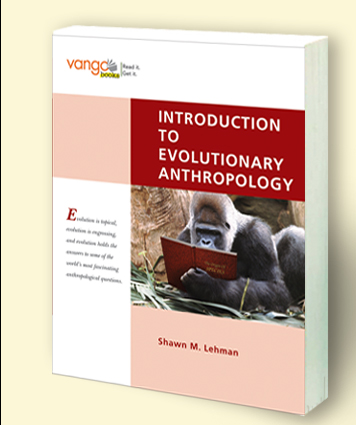

|
Table of Contents – Highlights of the Chapters Chapter 1: Introduction to Evolutionary Anthropology This chapter introduces students to the modern, holistic application of anthropological theory in the following five disciplines: sociocultural, linguistics and semiotics, archaeology, medical, and biological anthropology. With this background, the biological subfield of evolutionary anthropology is introduced, as is the scientific method. I then provide a short review of the historical development of evolutionary concepts, including an appraisal of Charles Darwin’s life and of how he came to formulate his theory of natural selection. The chapter concludes with a short review of Gregor Mendel’s work on trait inheritance and a discussion of why creationism and “intelligent design” are scientifically bankrupt. Chapter 2: Microevolution and Evolutionary Anthropology In this chapter, I introduce the main processes and patterns in modern evolutionary theory as they pertain to microevolution. What’s microevolution? Put simply, it refers to small changes in evolution, such as a change in a population’s gene pool over a succession of generations. I begin the review by looking at the genetic basis of inheritance. My use of simplified examples of transcription and translation enables students to better understand what exactly was going on at the genetic level in Mendel’s experiments. From there, I delve into genetic changes at the population level. Finally, I review the four mechanisms of biological evolution: mutation, genetic drift, gene flow, and natural selection. I conclude the chapter by clearing up common misconceptions regarding natural selection and mutation. Chapter 3: Macroevolution and Evolutionary Anthropology This chapter covers macroevolution, which encompasses large-scale changes at or above the species level extending over geologic eras and resulting in the formation of new taxonomic groups. I explore fundamental issues of species concepts and how species evolve. I then expand the review of modern evolutionary theory from the species level to that of a community of different species in space and time. Finally, I describe the modern synthesis, which establishes the primacy of biological evolution for understanding the history of life on our planet. Chapter 4: Living Primates The purpose of this chapter is to introduce students to the exciting science of primate studies in evolutionary anthropology. Students use an up-to-date taxonomy for primates to provide order for a general review of living primates. I then provide specifics on how to differentiate the various taxonomic groups within the Order. There is an extensive and lively discussion of fundamental aspects of the evolutionary anthropology of primates, including body size, ecology and behaviour, and conservation. Chapter 5: Primate Origins This chapter offers a review of the evolutionary anthropology of non-human primates in the fossil record. The major goal of the chapter is to give students an understanding of how and why primates evolved from the time of the dinosaurs up until the emergence of the first hominins. Each section starts with a review of the major global patterns of geography and climate. This information is needed to understand how environmental factors influenced primate macroevolution. I undertake a brief review of the major morphological characteristics and ecological interpretations of the primates associated with that epoch. Finally, I piece together the phylogenetic relationships of early primates. Chapter 6: The Earliest Fossil Hominins In this chapter, students meet species that may be our earliest common ancestors with living apes. Specifically, students learn about major trends in the evolutionary anthropology of human origins during the Pliocene and Pleistocene epochs. Major fossil species receive a brief review of their morphological characteristics and ecology. This chapter sets the stage for understanding the broad evolutionary patterns that resulted in human origins. Chapter 7: Human Origins: Rise of the Genus Homo This chapter introduces students to paleoanthropology as an exciting and rewarding academic pursuit. I discuss the evolutionary anthropology of human origins starting with the emergence of the first species in our genus (Homo). Students also learn about the origins of and changes in tool use over the course of millions of years. Finally, I piece together the phylogenetic relationships of hominins. Chapter 8: Human Variation In this chapter, students learn that evolutionary anthropologists are at the forefront of science in documenting phenotypic and genetic diversity of modern humans. This research seeks to provide us with an improved understanding of where we came from and why we look the way we do. Thus, the purpose of this chapter is to discuss the evolutionary anthropology of human variation. I start with looking at the main hypotheses on human origins, followed by a review of human adaptations, ranging from body size to disease. Finally, I provide a detailed, evolutionary perspective on the fallacies of human race concepts and so-called racial abilities. Chapter 9: Applied Anthropology The book concludes with a discussion of the application of anthropological knowledge to solve practical problems. In the course of conducting their research, many evolutionary anthropologists have an opportunity to assist in resolving environmental issues with their study animals, or social and health problems with local human populations. I also discuss specifics of the practical application of anthropological knowledge in primatology, medical anthropology, and forensic anthropology. I conclude the chapter with a review of forensic anthropology—the application of skeletal biology to issues within a legal setting. |
AVAILABLE FEBRUARY 2009
© 2010 • ISBN-10: 0132078228 • 256 Pages
ISBN-13: 9780132078221
If you would like an exam copy of this text,
find your Pearson rep by clicking below:
REP LOCATOR
ISBN-13: 9780132078221
If you would like an exam copy of this text,
find your Pearson rep by clicking below:
| Copyright 2008 Pearson Education Canada,a division of Pearson Canada, Inc. All rights reserved. |